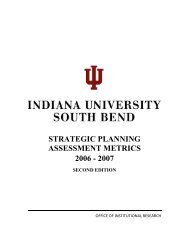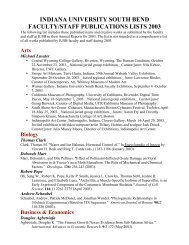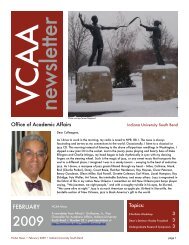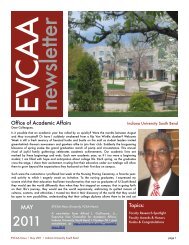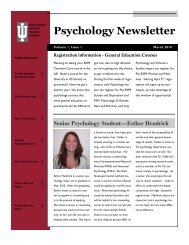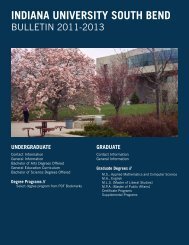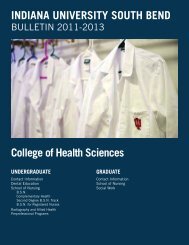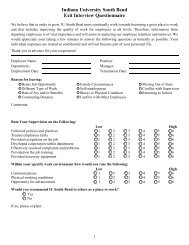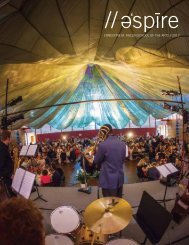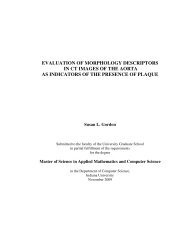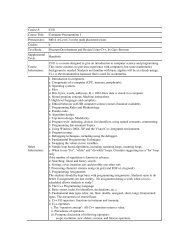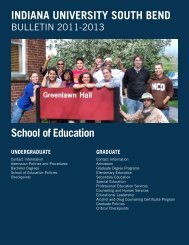Current version - Indiana University South Bend
Current version - Indiana University South Bend
Current version - Indiana University South Bend
Create successful ePaper yourself
Turn your PDF publications into a flip-book with our unique Google optimized e-Paper software.
3783 IU SOUTH BEND COURSE DESCRIPTIONS<br />
PHYS-P 323<br />
PHYS-P 324<br />
PHYS-P 331<br />
PHYS-P 334<br />
PHYS-P 340<br />
PHYS-P 410<br />
PHYS-P 441<br />
PHYSICS 3 (3 cr.)<br />
P: MATH-M 216, PHYS-P 222. Third<br />
semester of a four-semester sequence.<br />
Special relativity, introduction to<br />
quantum theory, Schroedinger equation,<br />
the hydrogen atom, many-electron<br />
atoms, statistical physics, molecules, and<br />
solids. I<br />
PHYSICS 4 (3 cr.)<br />
P: MATH-M 216, PHYS-P 323. Fourth semester<br />
of a four-semester sequence. Conduction in<br />
metals; semiconductors; superconductivity;<br />
nuclear structure, reactions, and applications;<br />
radioactivity; elementary particles; cosmology;<br />
introduction to general relativity. II (odd years)<br />
Theory of Electricity and<br />
Magnetism (3 cr.)<br />
P: PHYS-P 222, MATH-M 216.<br />
Electrostatic potentials and electric<br />
fields, differential operators, Laplace and<br />
Poisson equations, dielectric materials,<br />
steady currents, power and energy,<br />
induction, magnetic fields, scalar and<br />
vector potentials, Maxwell’s equations. I<br />
(odd years)<br />
Fundamentals of Optics (3 cr.)<br />
P: PHYS-P 222, MATH-M 216.<br />
Geometrical optics: matrix formulation<br />
of the laws of reflection and refraction,<br />
ray tracing with computers, aberrations.<br />
Physical optics: interference, diffraction,<br />
polarization, lasers, holography.<br />
Thermodynamics and Statistical<br />
Mechanics (3 cr.)<br />
P: MATH-M 216, PHYS-P 323.<br />
Intermediate course covering the three<br />
laws of thermodynamics, classical and<br />
quantum statistical mechanics, and some<br />
applications. II (even years)<br />
computing applications in physics<br />
(3 cr.)<br />
P: MATH-M 216, PHYS-P 222. Computing<br />
methods and techniques applied to a broad<br />
spectrum of physics problems. Emphasis<br />
on least-squares method and other curvefitting<br />
techniques of nonlinear functions;<br />
montecarlo methods; data manipulation,<br />
including sorting, retrieval, and display.<br />
Analytical Mechanics I (3 cr.)<br />
P: PHYS-P 222, MATH-M 216. C:<br />
MATH-M 343 or consent of instructor.<br />
Elementary mechanics of particles<br />
and rigid bodies treated by methods<br />
of calculus and differential equations.<br />
Hamiltonian and Lagrangian methods,<br />
continuum mechanics. I (even years)<br />
PHYS-P 453<br />
PHYS-P 473<br />
PHYS-S 106<br />
PHYS-S 405<br />
PHYS-S 406<br />
PHYS-T 105<br />
Introduction to Quantum Mechanics<br />
(3 cr.)<br />
P: PHYS-P 323. C: MATH-M 343 or consent<br />
of instructor. The Schroedinger Equation<br />
with applications to problems such as<br />
barrier transmission, harmonic oscillation,<br />
and the hydrogen atom. Discussion of<br />
orbital and spin angular momentum,<br />
and identical particles. Introduction to<br />
perturbation theory. II (odd years)<br />
introduction to string theory (3 cr.)<br />
P: MATH-M 216, PHYS-P 323.<br />
Introduction to the fundamentals of<br />
string theory and some of its current<br />
applications. Main themes include the<br />
formulation of relativistic strings in<br />
terms of the Nambu-Goto action and the<br />
quantized string state space of open and<br />
closed strings. Applications include string<br />
compactification, T-duality of open and<br />
closed strings, and D-branes.<br />
CONTEMPORARY PHYSICS SEMINAR (1 cr.)<br />
This course provides early exposure to<br />
current and exciting topics in physics<br />
and related fields at a qualitative level.<br />
Sessions include presentations by faculty,<br />
advanced students, and visiting scientists.<br />
I, II<br />
Readings in Physics (1-3 cr.)<br />
P: Consent of instructor. Independent<br />
reading under supervision of a faculty<br />
member. Study in depth of a topic of<br />
interest to the student, culminating in a<br />
research paper.<br />
Research project (1-6 cr.)<br />
P: Consent of instructor. Research<br />
participation in group or independent<br />
project under the supervision of a faculty<br />
member in department research areas; or<br />
topic agreed upon between the student and<br />
supervisor. Alternatively, internship in<br />
industry or national laboratory, arranged<br />
between the student, the student’s faculty<br />
mentor, and internship supervisor.<br />
PHYSICAL SCIENCE FOR ELEMENTARY<br />
TEACHERS (4 cr.)<br />
P: MATH-T 101. Principles of physical<br />
science with focus on elementary<br />
chemistry and physics. Laboratory,<br />
demonstration, and exploration enrich<br />
course material which develops the<br />
expertise needed for success in the<br />
elementary school classroom. Open<br />
only to elementary education majors.<br />
Does not satisfy the general-education<br />
requirement in the College of Liberal Arts<br />
and Sciences. II<br />
P = Prerequisite, R = Recommended, C = Concomitant, VT = Variable Title<br />
I = fall semester, II = spring semester, S = summer session(s)



